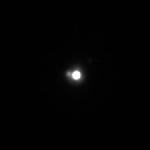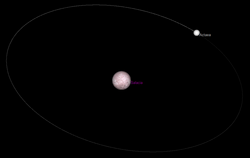(120347) Salacia
 | |
| Odkrywca | Henry G. Roe, |
|---|---|
| Data odkrycia | 22 września 2004[1] |
| Numer kolejny | 120347 |
| Oznaczenie tymczasowe | 2004 SB60 |
| Charakterystyka orbity (2020-05-31) | |
| Przynależność obiektu | |
| Półoś wielka | |
| Mimośród | 0,1064[1] |
| Peryhelium | |
| Aphelium | |
| Okres obiegu wokół Słońca | 274,0[1] lata |
| Inklinacja | 23,92[1]° |
| Charakterystyka fizyczna | |
| Średnica | |
| Masa | (4,92 ± 0,07) × 1020[3] kg |
| Średnia gęstość | 1,26 ± 0,16[3] g/cm3 |
| Okres obrotu | |
| Albedo | 0,044 ± 0,004[4] |
| Jasność absolutna | |
| Satelity naturalne | |
(120347) Salacia – planetoida transneptunowa typu cubewano w Pasie Kuipera.
Planetoida została odkryta 22 września 2004 roku. Okrąża Słońce w średniej odległości 42,19 au w czasie 274 lat. Jej średnica szacowana jest na 854 ± 45 km[4].
Księżyc planetoidy
(120347) Salacia posiada naturalnego satelitę zwanego Actaea. Ma on średnicę szacowaną na ok. 286 km[4], obiega Salacię w czasie ok. 5,494 dnia[3]. Odległość między składnikami wynosi 5724 ± 27 km[3].
Zobacz też
- lista planetoid 120001–121000
- lista ponumerowanych planetoid
- lista planetoid z księżycami
Przypisy
- ↑ a b c d e f g h i j k (120347) Salacia w bazie Jet Propulsion Laboratory (ang.)
- ↑ a b Wm. Robert Johnston: List of Known Trans-Neptunian Objects (ang.). Johnston's Archive, 2020-08-18. [dostęp 2020-12-28].
- ↑ a b c d e f g Wm. Robert Johnston: (120347) Salacia and Actaea (ang.). Johnston's Archive, 2019-05-27. [dostęp 2020-12-28].
- ↑ a b c d S. Fornasier et al.. TNOs are Cool: A survey of the trans-Neptunian region. VIII. Combined Herschel PACS and SPIRE observations of 9 bright targets at 70–500 μm. „Astronomy & Astrophysics”. 555, s. A15, lipiec 2013. DOI: 10.1051/0004-6361/201321329 (ang.).
Linki zewnętrzne
- Diagram orbity (120347) Salacia w bazie Jet Propulsion Laboratory (ang.)
- (120347) Salacia w bazie Minor Planet Center (ang.)
Media użyte na tej stronie
Autor: Tomruen, Licencja: CC BY-SA 4.0
Simulated orbit of en:120347 Salacia and en:Actaea (moon), scale model with view inclined from orbital plane, compare to diagram at [1]
This is a revised version of Solar_System_XXIX.png.
Autor: Renerpho, Licencja: CC BY-SA 4.0
Salacia and its moon Actaea, imaged by the Hubble Space Telescope on 21 July 2006.




